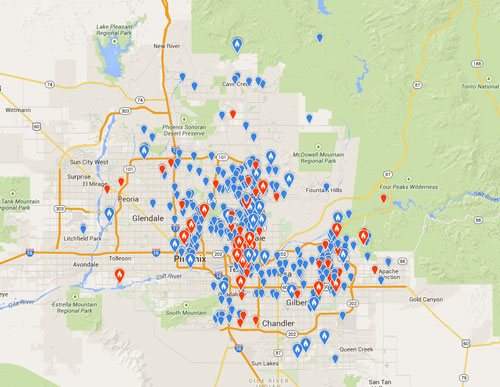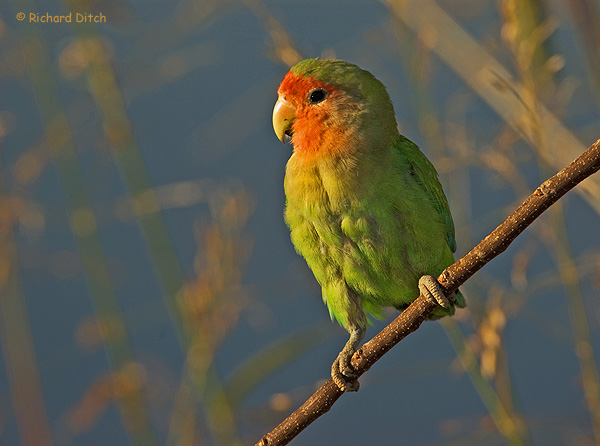 |
|||||||||||||||||||||
|
AZFO VOLUNTEERS NEEDED IN GREATER PHOENIX METRO AREA
Saturday, 21 February 2015
Morning commitment only
Join AZFO on Saturday 21 February 2015 for a 5 year anniversary census of the Rosy-faced Lovebird in Phoenix.
The original census was conducted 27 February 2010 by the
Arizona Field Ornithologists (AZFO) to establish a quantitative
baseline understanding of the population, and the results were
published in the AZFO Online Journal. See the published results
here:
http://azfo.org/journal/Rosy-facedLovebird2011.html
Once the above results were published, Radamaker and Corman submitted a formal request to the Arizona Bird Records Committee (ABC) to accept the Rosy-faced Lovebird to the official state list. At the 2011 meeting of the ABC the Rosy-faced Lovebird was officially accepted.
Once the state accepted Rosy-faced Lovebird, a formal request was submitted to the American Birding Association (ABA) Checklist Committee. In 2012 the Rosy-faced Lovebird was officially accepted to the ABA Checklist and published in Birding Volume 12-6. A photo of Rosy-faced Lovebirds by Arizona own Cindy Marple graced the cover . See the ABA blog by Cindy Marple here: http://blog.aba.org/2012/12/lovebird-intro.html
Details about Census
Primary census areas will be within the core of known populations in the cities of Apache Junction, Mesa, Gilbert, Tempe, Scottsdale and Phoenix. However, if sufficient numbers of folks participate, we would welcome other areas with lovebirds to be surveyed as well.
Goal is to determine general numbers to estimate the total population and distribution within the Greater Phoenix Metropolitan Area. This baseline information will be used to track future population change and will be included in an upcoming lovebird status article to be published on the AZFO web site.
Basic activity: Participants will be assigned specific sections of a city which they can easily survey between 0630 and 1000 AM, where they will visit known and likely neighborhoods listening for lovebirds. Click here to hear what a Rosy-faced Lovebird Sounds Like. Survey will likely include both walking and some driving, but biking would also be an excellent way to census. For each lovebird detection participants will document the closest street intersection and the number of individuals detected on census form provided.
If interested in participating, please forward your name, email address and general area of a specific city you would like to census to Kurt Radamaker kurtrad@mexicobirding.com
Major Population area of Rosy-faced Lovebirds
Rosy-faced Lovebird sightings from eBird February 2015.
The Rosy-faced lovebird (Agapornis roseicollis) is native to southwestern Africa, where it is found up to an elevation of 1,500 m (Collar 1997). The range is poorly known, but it is generally found in Angola, southwards along the coast through Namibia to Northern Cape Province, South Africa (Juniper and Parr 1998). It is found in arid woodland, scrubby hillsides and tree-lined watercourses including river canyons, rocky terrain where area rainfall exceeds 100 mm, and where water is accessible (Collar 1997). It is a colonial breeder with natural breeding sites in the inaccessible and often vertical cracks found in steep rock-faces on exfoliating granite or sandstone koppies (Simmons 1997). However, it is highly adaptable and it nests and roosts in sociable weaver (Philetairus socius) nests, as well as artificial structures and junction boxes on telephone poles, and in otherwise inappropriate habitats (Simmons 1997).
It is widely bred in captivity for commercial purposes. Only 3 of over 500,000 specimens exported from 1992 through 2001 were reported as specimens of wild origin. In captivity, they breed easily. A pair can breed and rear three clutches (4-5 eggs per clutch) in a season. There 16 or more color mutations of this species produced in captivity, of which 8 are common, 7 are established, and 1 is considered rare (Martin 2002). Most color mutations are bred worldwide.
In Phoenix the Rosy-faced Lovebird was first noted breeding in the wild in 1987, and in recent years it has become a familiar and delightful part of the local avifauna.
Why should we census Rosy-faced Lovebirds?
In any environment it is important to understand the population and life history of non-native species and how they interact with the native avifauna. In addition, the Rosy-faced Lovebird is likely not established as an introduced exotic anywhere else in world. Providing a unique opportunity to study and understand how the Rosy-faced Lovebird has adapted to a foreign environment continents away!.
Resources:
The Rosy-faced Lovebird Team
Kurt Radamaker
Cave Creek AZ
![]() :kurtrad@mexicobirding.com
:kurtrad@mexicobirding.com
Troy Corman
Phoenix AZ
![]() :aplomado@COX.NET
:aplomado@COX.NET

If interested in participating, please forward your name, email address and general area of a specific city you would like to census to Kurt Radamaker kurtrad@mexicobirding.com